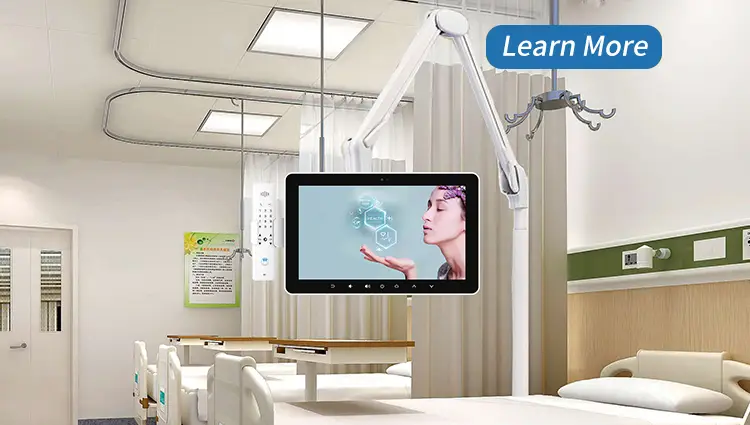As hospitals accelerate their digital transformation, the patient room has become more than a place for rest — it’s now the center of communication, education, and engagement. Traditionally, IPTV systems (ceiling- or wall-mounted patient TVs) were the standard solution for bedside entertainment.
However, as care models shift toward patient-centered smart wards, the Bedside Infotainment Terminal is emerging as a more versatile, intelligent, and integrated alternative.
This article breaks down the key differences between IPTV and Bedside Terminals across five critical dimensions: functionality, interaction, integration, efficiency, and patient experience.
1. System Architecture & Core Functionality
IPTV:
- Primarily designed for video streaming and TV broadcasting within hospital networks.
- Operates as a one-way entertainment system — offering movies, news, and local channels via set-top boxes or IP-based receivers.
- Limited interactivity and minimal linkage with hospital systems.
Bedside Infotainment Terminal:
- Functions as a multifunctional Android-based platform, supporting apps, medical software, and hospital integrations.
- Beyond entertainment, it offers access to EMR/HIS data, meal ordering, education modules, video calls, and nurse communication.
- Acts as a digital command center at the bedside — a key component in smart ward architecture.
2. Patient Interaction & Experience
IPTV:
- Controlled by a remote or wall button panel.
- No touch function, limited personalization.
- Suitable for passive entertainment but not active engagement.
Bedside Terminal:
- Touchscreen UI, personalized login, multilingual interface.
- Enables two-way communication between patients and staff — from service requests to teleconsultations.
- Integrates educational content, health videos, and even digital feedback forms to improve patient engagement.

3. Integration with Hospital IT Systems
IPTV:
- Rarely integrated with hospital information systems.
- Upgrades or customizations often require third-party middleware or new infrastructure.
Bedside Terminal:
- Fully compatible with HIS, EMR, PACS, Nurse Call, and PMS via APIs or SDKs.
- Enables real-time updates — for example, patients can view their treatment schedule or medication info directly on screen.
- Reduces administrative workload by digitalizing bedside operations.
4. Infrastructure, Power & Installation
IPTV:
- Requires separate power and signal cabling, plus wall or ceiling mounting.
- Maintenance can be complex and disruptive.
Bedside Terminal:
- Supports PoE/PoE+/UPoE, combining power and data in a single Ethernet cable.
- Simplifies installation, reduces wiring costs, and improves safety.
- Fanless, low-power design ensures silent operation ideal for patient environments.
5. Applications in Smart Ward Development
IPTV:
- Limited use in advanced smart ward functions.
- Suitable mainly for legacy environments focusing on entertainment only.
Bedside Terminal:
- Central to smart ward concepts — integrating clinical workflow, communication, and patient engagement.
- Used in digital nurse call systems, telemedicine, diet ordering, room control, and patient satisfaction analytics.
- Enables real-time data exchange and remote monitoring, aligning with the goals of connected healthcare.
6. ROI and Operational Value
IPTV:
- Lower initial cost but limited scalability.
- Generates minimal value beyond entertainment.
Bedside Terminal:
- Higher initial investment but significantly better ROI through improved efficiency, shorter nurse response times, and higher patient satisfaction scores.
- Offers upgrade flexibility via Android updates and app deployment — extending system life cycles.

The Future: Intelligent, Connected, and Patient-Centered
As hospitals adopt AI, cloud integration, and data analytics, the bedside terminal will evolve into an interactive node of care — integrating wearable data, remote consultations, and personalized treatment dashboards.
While IPTV still serves a role in basic entertainment, it’s clear that Bedside Infotainment Terminals are the foundation of smart, connected, and efficient wards — where technology enhances both care and comfort.
Final Thoughts
The difference between IPTV and bedside terminals is more than technology — it’s philosophy. IPTV entertains; bedside terminals empower. IPTV informs; bedside terminals connect. And in the era of smart healthcare, connection is everything.
https://www.linkedin.com/pulse/iptv-vs-bedside-infotainment-terminals-whats-right-modern-htpxc/

